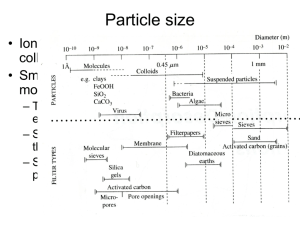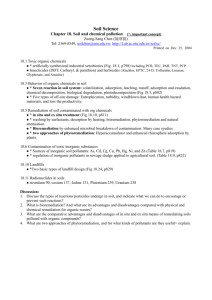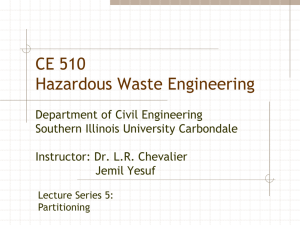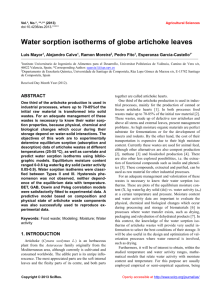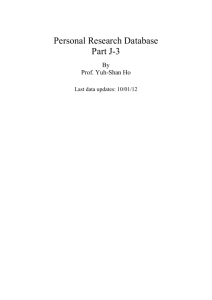Appendix A
advertisement
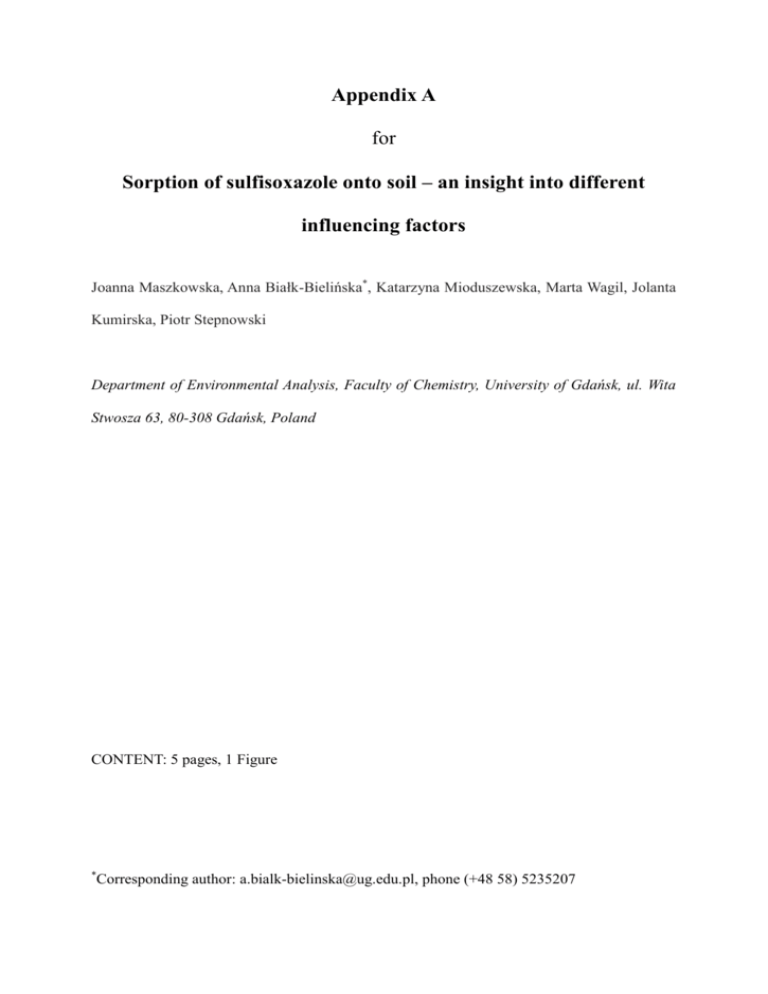
Appendix A for Sorption of sulfisoxazole onto soil – an insight into different influencing factors Joanna Maszkowska, Anna Białk-Bielińska*, Katarzyna Mioduszewska, Marta Wagil, Jolanta Kumirska, Piotr Stepnowski Department of Environmental Analysis, Faculty of Chemistry, University of Gdańsk, ul. Wita Stwosza 63, 80-308 Gdańsk, Poland CONTENT: 5 pages, 1 Figure * Corresponding author: a.bialk-bielinska@ug.edu.pl, phone (+48 58) 5235207 1. Description of the sorption test All samples were prepared in triplicate. Tests were performed using a laboratory shaker (RS 10 Control, IKA, Germany), ensuring constant contact with the soil sample solution containing SSX. To avoid photodegradation of SSX, the experiments took place in the dark (the tubes were covered with aluminum foil). Selection of the optimum soil/solution ratio was based on the calculated percentage of chemical adsorbed to soil, which should be > 20%, and preferably > 50%. The ratio was 1:2 for all soils. Equilibrium was achieved for all three media after 24 h. Each sorption experiment involved the following steps: (1) 1 g of air-dried soil sample was mixed with 2 mL of the spiked water solutions of SSX. Eight concentrations for determining the sorption isotherms were investigated (0.625, 1.25, 2.5, 5, 10, 20, 40, 80 µg mL-1); (2) the mixture was shaken for 24 h until adsorption equilibrium was reached; (3) samples were centrifuged at 4000 rpm (approx. G-force) for 10 min (MPW-250 Centrifuge, Warsaw, Poland), passed through 0.45 µm syringe filters (Chromafil® PET 15/25, Machery-Nagel, Düren, Germany) and placed in vials for HPLC separation and analysis. During this step some soil samples were also subjected to a desorption experiment. To attain desorption equilibrium, the desorption experiment was carried out by adding an extra amount of freshly prepared 0.01 M CaCl2 solution to the soil remaining in the centrifuge tubes to achieve a total liquid volume of 2 mL. Afterwards, the samples were again shaken for 24 h, centrifuged and filtered; (4) the concentration of test substance in the supernatant was analyzed by reverse-phase HPLC with UV detection. The strength and extent of the sorption phenomena were determined by sorption isotherms and sorption coefficients. Different isotherms (linear, Freundlich, Langmuir, DubininRadushkevich, Temkin) were used to obtain better characteristics of the sorption mechanism. The influence of external factors on SSX sorption, like solution pH and ionic strength, were 2 also investigated. For this purpose, the tests were conducted using 0.01 M CaCl2 at different pHs, obtained by adding different concentrations of HCl and KOH (for the pH-dependent sorption experiments), and using different salt concentrations (for the ionic strength – dependent sorption experiments). The sorption coefficients of SSX at different pH (pH at 3, 4, 5, 6, 7, 8, 9, 10, 11, 12) and ionic strength (0.0005 M, 0.001 M, 0.005 M, 0.01 M, 0.05 M and 0.1 M of CaCl2) were then determined in triplicate using the approach described above. 2. Calculations a) Linear sorption isotherm Eq. 1 𝑐𝑠 = 𝐾𝑑 ∙ 𝑐𝑤 where K d – partition coefficient (L kg-1), c S – content of test substance adsorbed on the soil at adsorption equilibrium (mg kg-1), cW – mass concentration of test substance in the aqueous phase at adsorption equilibrium (mg L-1). b) Freundlich isotherm model log c s 1 / n log c w log K F Eq. 2 where c S – content of test substance adsorbed onto the soil at adsorption equilibrium (mg kg-1), cW – mass concentration of test substance in the aqueous phase at adsorption equilibrium (mg L-1), K F – Freundlich adsorption coefficient (mg1-1/n kg -1 L1/n), n – regression constant denoting the degree of nonlinearity. To determine the constants K F and parameters 1/n the linear equation was used to plot a graph of log c S against log cW . Values of K F and 1/n were estimated by linear regression after log-log transformation. c) Langmuir isotherm model 3 1 1 1 = + cs K L cmax cw cmax Eq. 3 where c S – content of test substance adsorbed onto the soil at adsorption equilibrium (mg kg-1); cW – mass concentration of test substance in the aqueous phase at adsorption equilibrium (mg L-1); c max – maximum sorption capacity of the sorbent (mg kg-1); 1 1 K L – Langmuir constant (L mg-1). Hence by plotting c S against c W one can obtain the value of c max and K L from the conversion of Eq. 3 and the data from the curve equation. d) Dubinin-Radushkevich (D-R) isotherm model log cs log qD 2 BD R 2T 2 log( 1 1 ) cw Eq. 3 where c S – content of test substance adsorbed onto the soil at adsorption equilibrium (mg g-1), qD – theoretical isotherm saturation capacity (mg g-1), BD – Dubinin-Radushkevich isotherm constant related to adsorption energy (mol2 kJ-2), R – gas constant (0.008314 kJ mol-1 K-1), T – absolute temperature (298 K) and cW – mass concentration of test substance in the aqueous phase at adsorption equilibrium (mg L-1). e) Temkin isotherm model RT RT ln K 0 ln c w Q Q Eq. 5 where – fractional coverage (cs/cmax (mg g-1/ mg g-1); value of cmax determined using Langmuir equation), R – gas constant (0.008314 kJ mol-1 K-1), T – absolute temperature (298 K), Q – variation of adsorption energy (kJ mol-1) ( Q ( H ) . 4 Fig. 1S Langmuir, Freundlich, Dubinin-Radushkevich and Temkin isotherms of SSX. Freundlich isotherms 3 2 2.5 1.5 2 1 log cs [mg kg-1] 1/cs [kg mg-1] Langmuir isotherms 1.5 1 0.5 0 -1 0.5 -0.5 0 0.5 1 1.5 2 -0.5 0 0 1 2 3 1/cw [L Soil R20 4 5 -1 mg-1] log cw [mg L-1] Soil R21 Soil R13 Soil R20 Dubinin-Radushkevich isotherms Soil R21 Soil R13 Temkin isotherms 0 5 0 0.2 0.4 0.6 0.8 -0.5 4 3 -1.5 Ɵ log cs [mg g-1] -1 -2 2 -2.5 1 -3 -3.5 0 -2 -4 0 log (1+1/cw) Soil R20 Soil R21 Soil R13 2 4 6 lncw Soil R20 Soil R21 Soil R13 5

